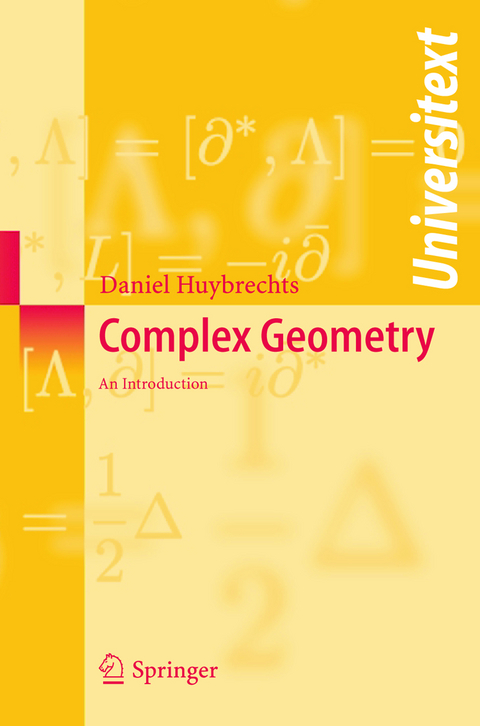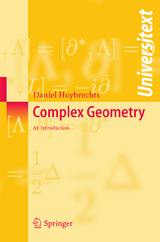Complex Geometry
Springer Berlin (Verlag)
978-3-540-21290-4 (ISBN)
Complex geometry studies (compact) complex manifolds. It discusses algebraic as well as metric aspects. The subject is on the crossroad of algebraic and differential geometry. Recent developments in string theory have made it an highly attractive area, both for mathematicians and theoretical physicists.
The author's goal is to provide an easily accessible introduction to the subject. The book contains detailed accounts of the basic concepts and the many exercises illustrate the theory. Appendices to various chapters allow an outlook to recent research directions.
Daniel Huybrechts is currently Professor of Mathematics at the University Denis Diderot in Paris.
Daniel Huybrechts, Studies of math at Humboldt University Berlin and Max-Planck-Institute Bonn 1985-1992. Post-doctorial positions at Inst. for Advanced Study Princeton, Ecole Normale Supérieure Paris, Max-Planck-Institute Bonn, University Essen, IHES Paris. Professor in Cologne 1998-2002. Since 2002 he is Professor of Mathematics at the University Denis Diderot in Paris.
Local Theory.- Complex Manifolds.- Kähler Manifolds.- Vector Bundles.- Applications of Cohomology.- Deformations of Complex Structures.
From the reviews:
"The book under review provides an introduction to the contemporary theory of compact complex manifolds, with a particular emphasis on Kähler manifolds in their various aspects and applications. As the author points out in the preface, the text is based on a two-semester course taught in 2001/2002 at the University of Cologne, Germany. Having been designed for third-year students, the aim of the course was to acquaint beginners in the field with some basic concepts, fundamental techniques, and important results in the theory of compact complex manifolds, without being neither too basic nor too sketchy. Also, as complex geometry has undergone tremendous developments during the past five decades, and become an indispensable framework in modern mathematical physics, the author has tried to teach the subject in such a way that would enable the students to understand the more recent developments in the field, too, up to some of the fascinating aspects of the stunning interplay between complex geometry and quantum field theory in theoretical physics. The present text, as an outgrowth of this special course in complex geometry, does evidently reflect these emphatic intentions of the author's in a masterly manner. Keeping the prerequisites from complex analysis and differential geometry to an absolute minimum, he provides a streamlined introduction to the theory of compact complex manifolds and Kählerian geometry, with many outlooks and applications, but without trying to be encyclopedic or panoramic. without trying to be encyclopedic or panoramic. As to the precise contents, the text consists of six chapters and two appendices. [...]
The author has added two general appendices at the end of the book. Those are
meant to help the unexperienced reader to recall a few basic concepts and facts from differential geometry, Hodge theory on differentiable manifolds, sheaf theory, and sheaf cohomology. This very user-friendly service makesthe entire introductory text more comfortable for less seasoned students, perhaps also for interested and mathematically less experienced physicists, although the author does not claim absolute self-containedness of the book. The entire text comes with a wealth of enlightening examples, historical remarks, comments and hints for further reading, outlooks to other directions of research, and numerous exercises after each section. The exercises are far from being bland and often quite demanding, but they should be mastered by ambitious and attentive readers, in the last resort after additional reading. Finally, there is a very rich bibliography of 118 references, also from the very recent research literature, which the author profusely refers to throughout the entire text. The whole exposition captivates by its clarity, profundity, versality, and didactical strategy, which lead the reader right to the more advanced literature in complex geometry as well as to the forefront of research in geometry and its applications to mathematical physics. No doubt, this book is an outstanding introduction to modern complex geometry."
KIeinert (Berlin), Zentralblatt für Mathematik 1055 (2005)
This is a very interesting and nice book. It provides a clear and deep introduction about complex geometry, namely the study of complex manifolds. These are differentiable manifolds endowed with the additional datum of a complex structure that is more rigid than the geometrical structures used in differential geometry. Complex geometry is on the crossroad of algebraic and differential geometry. Complex geometry is also becoming a stimulating and useful tool for theoretical physicists working in string theory and conformal field theory. The physicist, will be very glad to discover the interplay between complex geometry and supersymmetry and mirror symmetry.
The book begins by explaining the local theory and all you need to understand theglobal structure of complex manifolds. Then we get an introduction to the complex manifolds as such, where the reader can progressively perceive the difference between real manifolds and complex ones. Then he gets an account of the theory of Kälher manifolds. And the physicist will be glad to find therein a first step on the road going from complex geometry to conformal field theory and supersymmetry. One chapter is dedicated to the study of holomorphic vector bundles (connections, curvature, Chern classes). In this context, the reader will clarify the relations between Riemannian and Kälher geometries. With all this stuff it is then possible to focus on some applications of cohomology. This leads to a nice introduction to the famous Hirzebruch-Riemann-Roch theorem and to Kodaira vanishing and embedding theorems. The last chapter of the book tackles the very important topics of deformations of complex structures.
This chapter will be interesting especially for readers that are studying Calabi-Yau manifolds and mirror symmetries. The main text of the book is completed by two pedagogical appendices. One about Hodge theory and the other about sheaf cohomology.
Thus this beautiful textbook will be very interesting for both pure mathematicians and theoretical physicists working in recent domains of field theory. It can be used by students or scientists for a first introduction in this field. It is always very accessible and the reader will find a detailed account of the basic concepts and many well-chosen exercises that illustrate the theory. Many illuminating examples help the reader in the understanding of all fundamental notions. I could certainly recommend this textbook to my students attending my lectures on differential geometry.
Professor Dominique LAMBERT, University of Namur; Department « sciences, philosophies et sociétés » Rue de Bruxelles 61 B-5000 Namur Belgium
"As complex geometry has undergone tremendousdevelopments ... the author has tried to teach the subject in such a way that would enable the students to understand the more recent developments in the field ... . This very user-friendly ... more comfortable for less seasoned students ... . The entire text comes with a wealth of enlightening examples, historical remarks, comments and hints ... . Finally, there is a very rich bibliography ... . The whole exposition captivates by its clarity, profundity, versality, and didactical strategy ... . an outstanding introduction to modern complex geometry." (Werner Kleinert, Zentralblatt Math, Vol. 1055, 2005)
"The book contains detailed accounts of the basic concepts and the many exercises illustrate the theory. Appendices to various chapters allow an outlook to recent research directions." (L'Enseignment Mathematique, Vol. 50 (3-4), 2004)
"This is the book that a generation of complex geometers will wish had existed when they first learned the subject, and that the next generation of geometers will surely use. ... Inserted into the standard material are some excellent appendices to stimulate interest and further reading ... . the reader learning the basic material is brought quickly and often to some fascinating areas of current research. Exercises introduce many examples ... . The result is an excellent course in complex geometry." (Richard P. Thomas, Mathematical Reviews, 2005h)
"The book is based on a year course on complex geometry and its interaction with Riemannian geometry. It prepares a basic ground for a study of complex geometry as well as for understanding ideas coming recently from string theory. ... The book is a very good introduction to the subject and can be very useful both for mathematicians and mathematical physicists." (EMS Newsletter, June, 2005)
"The book under review is a textbook, based on a 2-semester course to third year undergraduates in the University of Cologne. ... In the UK I think the book would beregarded as more suitable for a masters' level course for students well versed in standard complex analysis and differential geometry." (Peter Giblin, The Mathematical Gazette, Vol. 91 (520), 2007)
| Erscheint lt. Verlag | 26.8.2004 |
|---|---|
| Reihe/Serie | Universitext |
| Zusatzinfo | XII, 314 p. |
| Verlagsort | Berlin |
| Sprache | englisch |
| Maße | 155 x 235 mm |
| Gewicht | 500 g |
| Themenwelt | Mathematik / Informatik ► Mathematik ► Analysis |
| Mathematik / Informatik ► Mathematik ► Geometrie / Topologie | |
| Naturwissenschaften ► Physik / Astronomie | |
| Schlagworte | area • Calabi-Yau metrics • complex manifolds • Geometrie; Handbuch/Lehrbuch • Holomorphic vector bundles • Kaehler manifolds |
| ISBN-10 | 3-540-21290-6 / 3540212906 |
| ISBN-13 | 978-3-540-21290-4 / 9783540212904 |
| Zustand | Neuware |
| Haben Sie eine Frage zum Produkt? |
aus dem Bereich




